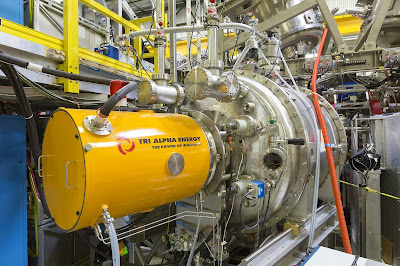I fully support the development of the ITER (International Thermonuclear Experimental Reactor) Project, located in Saint-Paul-lès-Durance, France. We have spent almost nothing on fusion power development over the past half-century (the US, which is the largest player, has invested only about a billion dollars a year, and presently spends less than that annually).
By way of contrast, over the past decade, there has been a $50 billion per year investment in hydrocarbon fracking in the US alone. I maintain that had we put that one trillion dollars into fusion power development, we'd have working prototypes today.
Watching this recent (well-produced) video reinforces my conviction that almost nobody understands the unique challenges and opportunities posed by the task of figuring out how to contain fusion power and make it work on earth. This video offers the "standard line" on the ITER reactor, which is the world's most expensive and most advanced fusion power project --- but almost certainly not the "best."
As pointed out here, ITER is presently projected to cost $20 billion (it was originally priced at $5 billion), and let's round that up to $50 billion, just to allow some leeway. As noted, that amount is only one year's investment in hydrocarbon fracking in the United States alone. In other words, this project is not an over-priced albatross (I think it is "too big," but that is a separate problem).
The Joint European Torus (JET) experiment in the UK is another large-scale, "mainstream" fusion project. It was originally developed by EUROfusion as a prototype for the larger ITER project. In turn, a DEMO project is intended to provide power to the grid --- though far in the future.

I argue that ITER should be much more richly funded than it is, as should the nine alternative ("small") fusion power projects currently under development (see below):
Alternative designs and associated companies
Levitated Dipole Experiment (MIT “plasma pinch”)
Compact Spherical Tokamak - Tokamak Energy Ltd. - spherical tokamaks + high-temperature
superconductors
Colliding beam reactor - Tri Alpha Energy Ion beams - aneutronic fusion power.
Polywell
- EMC2 company
Magnetized
target reactor (acoustic fusion) – General Fusion (Richmond, British Columbia)
Dense
Plasma Focus - LPP Fusion
Compact Fusion - Lockheed Martin (Skunkworks)
Sheared Flow Stabilized Z-Pinch – University of Washington & Lawrence Livermore
Laboratory (added by L. Hunt)
Wendelstein 7-X - Max Planck Institute for Plasma Physics (IPP) in Greifswald, Germany (added by L. Hunt: one of 11 operational stellarators, two more planned)
I have provided links to each of the nine projects I have identified (seven are from Fusion Wiki). I encourage the interested reader to explore all nine.
I have provided links to each of the nine projects I have identified (seven are from Fusion Wiki). I encourage the interested reader to explore all nine.
For the super-motivated reader, check out the World Nuclear Association progress review, or examine this very exhaustive (US-focused) summary of fusion projects and resources from the US Department of Energy: Fusion Energy Sciences Research Summary
The author --- Sir Christopher Llewellyn Smith - understands the theoretical context of fusion power in a way that no one else does. Here's a little information about him, from Wikipedia.

Perhaps most importantly, Dr. Smith points out that the release of energy from a fusion reaction is ten million times greater than from a typical chemical reaction (both hydrocarbon and solar technologies produce power through chemical reactions). It is also 3-4 times more energetic than fission power, and dramatically safer (down the road, boronic (or aneutronic) fusion produces an electrical current without emitting neutrons or any other dangerous radiation, promising perhaps the ultimate power source for life on earth).
I suggest a simple strategy going forward.
I'm a liberal libertarian in political philosophy, which, in brief, means that I see a role for government primarily in infrastructure development (with corresponding limited interference in markets). There is no infrastructure more important for humans at this time than fusion power. Thus, I am wide open to whatever public-private partnerships can be struck (and I'm totally fine if some bold investor or group of investors is richly rewarded for making an early investment in fusion technology --- this is why capitalism works and nothing else does).
We'd be wise to begin thinking about it now, but also to magnify greatly our efforts to get ourselves there!
23 November 2016: Here is a link to a very friendly video on fusion power that is easy to follow and exceptionally well-produced. This video will also help you understand why we may end up mining helium on the moon: Fusion Energy Explained – Future or Failure.
_









No comments:
Post a Comment